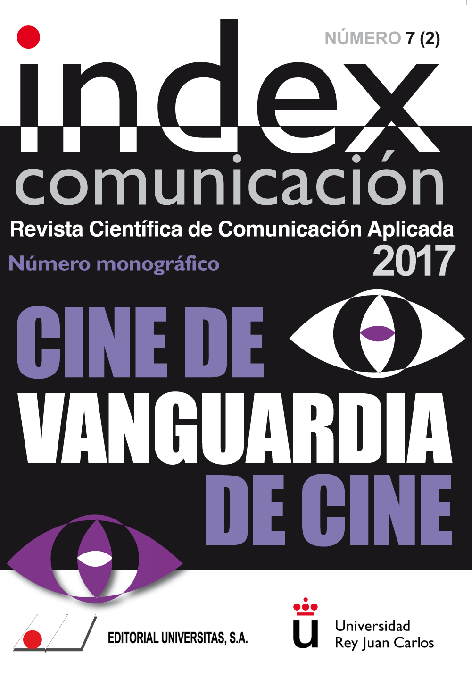Synesthesia and rhythm. The road to absolute cinema
Keywords:
Absolute cinema, visual music, historical avant-garde, synesthesia, organ color, animation cinema, abstract cinemaAbstract
Absolute cinema, developed during the historical avant-garde, con-tinued with a long artistic tradition that linked musical with visual experience. Due to cinema as médium of expression, this filmmakers were able to work with the moving image to develop concepts such as rhythm, also with more complex figures than the colored spots that other devices could create at those time. This study starts with the published texts in 1704 by Newton about color, and provides an overview of those artistic highlights that link image and sound, and which creates the origins of absolute cinema. The connections and equivalences between the visual and sound experiences used by these filmmakers are also studied in order to know if there was a continuous line with the origins of these studies or if there was a rupture and other later investigations were able to have more repercussion in their works.
Metrics
References
-Aristóteles (s.f./1980). Del Sentido y lo Sensible, de la Memoria y el Recuerdo. Traducción de Francisco de Samaranch, España: Aguilar.
-Arnaldo, J. (2003). Analogías musicales. Kandisnky y sus contemporáneos. Madrid: Fundación Colección Thyssen-Bornemisza.
-Bishop, B. (1893). A Souvenir of the Color Organ,
with Some Suggestions in Regard to the Soul of the Rainbow and the Harmony of Light. New York.
-Carrá, C. (1912). The painting of sounds, noises and smells. Lacerba. Disponible online en http://www.unknown.nu/futurism/paintsound.html
-Castel, L.B. (1740). L'optique des couleurs : fondée sur les simples observations, & tournée sur-tout à la pratique de la peinture, de la teinture, & des autres arts coloristes. Paris: Chez Briasson.
-Collopy, F. (2000). Color, Form, and Motion. Leonardo.Vol. 33, No 5.
-Collopy, F. (2009). Playing (Whith) Color. Glimpse, The art and science of seeing. Vol. (2), pp.62-67.
-Corra, B. (1912). Abstract Cinema - Chromatic Music. Il pastore, il gregge e la zampogna, Disponible online en http://www.unknown.nu/futurism/abstract.html
-Deutch, J (2012). Synaesthesia and Synergy in art. En F.G. Bartth y P. Giampieri-Deutsch (ed.) Sensory Perception. Viena: Springer WienNewYork.
-Elder, R.B. (2008). Film and Avant-garde Art Movements in the Early Twentieth Century. Canada: Wilfrid Laurier University Press.
-Frassen, M. (1991). The ocular harpsichord of Louis-Bertrand Castel. Tractrix, No 3.
-Jewanski, J. (S.f.). Color Organs. Disponible en http://see-this-sound.at/print/69
-Kahn, D. (2001). Noise, water, meat. A history of sound in the arts. London: The MIT Press.
-Kandinsky, V. (1996). De lo espiritual en el arte. 1912. Barcelona: Paidós.
-Kandinsky, W. (2003). Carta remitida por Wasili Kandinsky a Arnold Schönberg a, 18 enero 1911. En J. Auner. A Schoenberg Reader: Documents of a Life. Estados Unidos de America: Yale University.
-Le Grice. M. (1979). German Abstract Film in the Twenties. En Film as Film. Formal experiment in film 1910-1975. Londres: Hayward Gallery.
-Leslie, E. (2007). Where abstraction and comics collide. Tete, etc. No. 7, verano.
-Marinetti, F.T. Corra, B. Settimelli, E. Ginna, A. Balla, G. Chiti, R. (1985). El manifiesto futurista. En J. Romaguera y Ramió, H. Alvina (eds.) Textos y manifiestos del cine. Disciplinas, fuentes, innovaciones. Barcelona: Fontamara.
-Mitry, J.(1974). Historia del cine experimental. Valencia: Fernando Torres.
-Moritz, W, (1994). Color Harmony/Color Music. En El color en el arte mexicano. México DF: Universidad Nacional Autónoma de México.
-Moritz, W. (1991). Restoring the Aesthetics of Early Abstract Films. Swedish Avantgarde Film 1924-1990. New York: Anthology Film Archives.
-Moritz, W.(1995). Musique de la Couleur - Cinéma Intégral. En: Nicole Brenez et Miles Mc Kane, eds. Poétique de la couleur, une histoire du cinéma expérimental. Paris, Ed. Louvre/ Institut de l’image.
-Peacock, K. (1988). Instruments to Perform Color-Music:Two Centuries of Technological Experimentation. Leonardo, Vol. 21, No. 4.
-Putnam, S. (1929). The Glistening Bridge. Leopold Survage and the Spatial Problem in Painting. Covici-Friede, Nueva York.
-Rees, A.L. (1999). A History of Experimental Film and Video. From the Canonical Avant-Garde to Contemporary British Practice. BFI Publishing.
-Richter, H. (1952). Easel-Scrool-Film. Magazine of Art. Febrero.
-Rimington, A.W. (2004). Colour- Music. Londres: Wildside Press
-Rogers, H (2013) Sounding the Gallery: Video and the Rise of Art-Music. New York: Oxford University Press.
-Schönberg, A. (2003). Carta remitida por Arnold Schönberg a Wasili Kandinsky, 24 Enero de 1911. En J. Auner. A Schoenberg Reader: Documents of a Life. Estados Unidos de America: Yale University.
-Sons et Lumieres. Une historie du son dans l'art du XX siècle. (2004). Catálogo de exposición. Paris: Centre Pompidou.
-Waldman, G. (2002). Introduction to Light: The Physics of Light, Vision, and Color. New York: Dover Publicatios.
-Zilczer, J. (2005). Music for the eye: Abstract Painting and Light Art. En Visual Music. Alemania: The Museum of Contemporary Art, Los Angeles. Disponible en: http://www.rhythmiclight.com/books/TheGlisteningBridge.pdf
Published
How to Cite
Issue
Section
License
Authors who submit to this journal agree to the following terms:
Authors retain copyright and ensure the magazine's right to be the first publication of the work as licensed under a Creative Commons Attribution-NoComercial 4.0 International License that allows others to share the work with an acknowledgment of authorship of the work and the initial publication in this magazine, with no commercial purpose.
Authors can establish separate additional agreements for non-exclusive distribution of the version of the work published in the magazine (for example, to an institutional repository or publish it in a book), with an acknowledgment of its initial publication in this journal.
It allows and authors are encouraged to disseminate their work electronically (eg, in institutional repositories or on their own website) prior to and during the submission process, as it can lead to productive exchanges, as well as a citation more early and most of the published work (See The Effect of Open Access).















